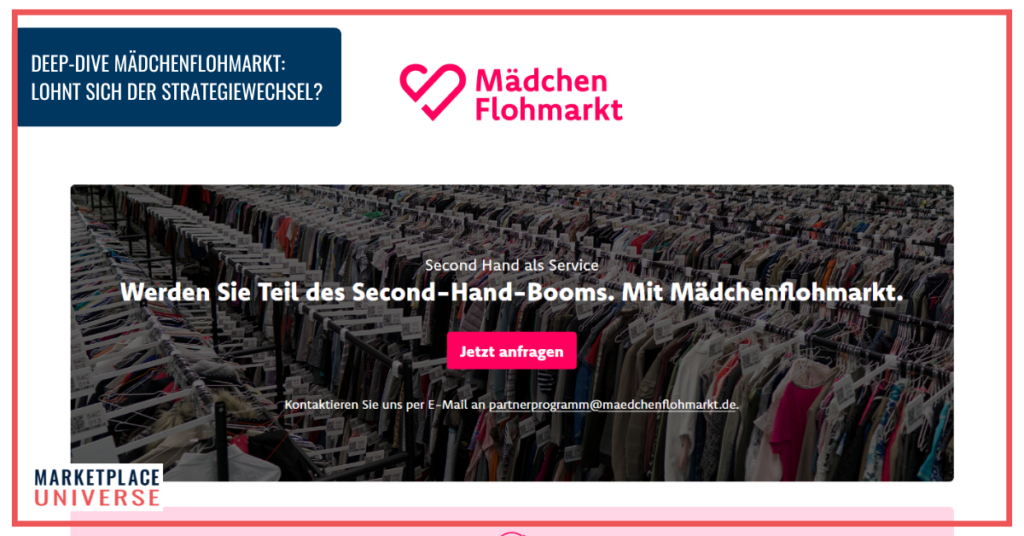
Vinted is squandering its investors’ millions on one acquisition after another, Mädchenflohmarkt tries a new marketplace strategy after the Wegner washout, and H&M is enjoying an unexpected windfall from its majority stake in thrift retailer Sellpy. There is a lot going on in the secondhand fashion market. But sooner or later, the same applies here: You have to stay in the black to stay in business.
Savior in need with new marketplace strategy
A few days after the official insolvency filing, however, a prominent investor was found: Christian Wegner, ex-Momox founder and co-founder of Stuffle.com. “My goal with Stuffle is to create a world where people buy more used stuff than new stuff – in every product category,” Christian told me in a recent interview. “That’s why I’m also looking at the second-hand fashion market – and when Mädchenflohmarkt, one of the biggest and best-known German players with its own pretty cool software, went bankrupt last year, I stepped in. Now we’re working on turning Mädchenflohmarkt into a functioning, profitable company.
The cross of profitability
“A functioning, profitable business” – Christian says it so simply, but in fact many business dreams in the Second-Hand fashion market have already failed because of this goal. “Size is a crucial issue in the Second-Hand fashion business,” says Second-Hand expert Karo Junker de Neui, founder and CEO of the luxury Second-Hand fashion retailer Vite enVogue until 2018. “The larger the store, the easier and more stable the assortment, the higher the rotation in the assortment and the higher the awareness, the cheaper it is to acquire buyers and sellers. Profitability in this area is very closely linked to large volumes.
However, even large volumes are no guarantee of profitability, as can be seen from the example of Europe’s largest player, Vinted. The company has been on the market since 2013 and has so far raised more than $500 million from 10 investors in six investor rounds – but is still not profitable: in 2022, Vinted generated revenues of €373 million (+51%), but still made a loss of €40 million (-62%). However, this does not stop Vinted from going on a shopping spree across Europe: in January 2024, Vinted took over the largest Danish second-hand marketplace Trendsales, and in 2022, the company swallowed up the German luxury accessories player Rebelle.
Profitability is therefore a big challenge in the second-hand fashion market – but not an impossible one, as a look at H&M‘s figures shows: In 2019, the Swedish retailer became the majority shareholder of the then unprofitable second-hand platform Sellpy. In the current annual figures, Sellpy makes a small but noticeable contribution to the company’s profit.
Can Mädchenflohmarkt make it with its new Marketplace strategy?
That depends on two things: the processes and the revenue streams. When it comes to processes, Christian Wegner, who wants his new project, Stuffle, to be profitable by next year at the latest, has used all his experience to give Mädchenflohmarkt a thorough overhaul. “In the secondhand sector, you have to be extremely tight with your logistics processes and, above all, your costs,” says Christian. “For this reason, the growth of Mädchenflohmarkt is of secondary importance to us for the time being; instead, we have streamlined the logistics processes. Especially in logistics and the concierge service (a service in which Mädchenflohmarkt takes care of product preparation, product listing and pricing for C2C sellers, editor’s note), we have already halved the time it takes to receive goods”.
The second step followed last week with the announcement of an exciting new marketplace strategy: Mädchenflohmarkt is opening its C2C marketplace to B2C sellers. “Mädchenflohmarkt already had the entire marketplace software in place, so the step to connect B2B partners wasn’t that big,” says Christian. “We are already in talks with second-hand retailers about a connection. We can also imagine other forms of cooperation with B2B partners. For example, our logistics processes with the concierge service could also be used by B2B partners for returns processing. But that’s still a long way off.
First B2C-Partners are found
The platform is thus opening up its access to around 2 million loyal second-hand customers to interested third parties – and at the same time offering them access to its processes. The first B2C partners are, not surprisingly, Stuffle.com and Vite enVogue, in which Christian Wegner is now also involved as an investor. “The idea is not completely new,” says Karo Junker de Neui. “In fact, About You’s marketplace already offers something similar in the pre-loved segment.
Mädchenflohmarkt and Vite enVogue are also connected there as sellers. Karo believes that retailers can definitely benefit from the connection to the new B2C marketplace with its high level of awareness, even if she fears that the various second-hand platforms will become uniform and ultimately lead to interchangeable product ranges.
And what about brand manufacturers?
Shouldn’t they welcome a platform like Mädchenflohmarkt, which has experience in processing and authenticating used fashion items – especially in light of the upcoming EU Eco-Design Directive, which could make it much more difficult for brands to destroy unsold goods?
“For years, manufacturers and brands have not only avoided the issue of used fashion, they have actively discouraged it,” says Karo Junker. “This is changing, but it’s happening at a snail’s pace. That’s why I can’t imagine that brands will welcome the marketplace Mädchenflohmarkt as a first step. There is certainly cooperation between brands and retailers in the second-hand market, but it usually takes place behind the scenes and out of the public eye.
With its new marketplace strategy, Mädchenflohmarkt first has to convince the second-hand traders of its marketplace. And continue to optimize its processes. It is quite possible that the future of the German Second-Hand fashion market will be decided this year.